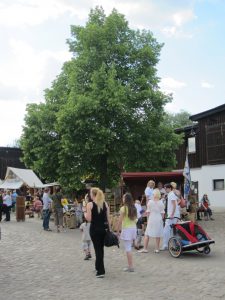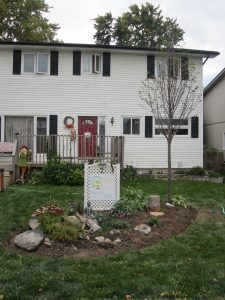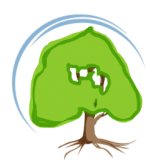
A full-grown Linden in an old farm yard in Berlin, Germany during a summer festival.
Last weekend, on the Thanksgiving weekend of 2016, my husband and I planted a Linden tree in our front yard. My husband had promised me one when we moved to our new home last year and after taking care of the most necessary renovations inside, this was the weekend to plant our own little tree.
We got a beautiful tree, not too big and not too small, and so far everyone has been commenting on how nice it looks, especially what a nice shape it has, even without many leaves. Usually this is followed by the question: “So, what kind of tree is it?” And then by: “What is a Linden tree?” (or sometimes: “Why a Linden tree?”). Well, here are the answers!
Linden trees (also known as lime trees or basswood in North America) are a very common sight in Germany. Streets and parks are lined with them and their sweet scent in the early days of summer draws bees and people alike to them. In the spring their new leaves are light green and soft to the touch but by July they turn dark green and strong and the trees provide reliable shade in the heat of summer.
Linden are community trees. At some point in its history almost every village in Germany had in its centre a Linden tree (the alternative often was an oak tree). Judgement was spoken under Linden; marriages were performed in the fragrant clouds of their sweet-smelling flowers; festivals and dances and community meetings were held under their leaves. Linden trees were said to bring luck, protect from fire and other harm, make happy, and heal. But most of all, they were the trees under which people met, dreamt, spoke, loved, and grieved.
Linden flower tea was and still is used to help with anxiety, to support the body’s immune system, to heal colds and indigestion, to help with respiratory issues, and much more. Linden flower honey, a very special, light honey that carries the subtle scent of Linden flowers, is a delicacy which is said to have an almost “breathtaking” effect on the beekeepers during the preparation process.
To me Linden also have a very personal connection. From early on in my life I have been looking forward to the one or two weeks, usually in late June, when the Linden trees are in flower. Like the bees (the German word for “bee” is “Biene” which is exactly the same sound as the short version of my name “Bine” — just like “B” is the same sound as “bee”) I am drawn to the trees. When my husband and I go for walks in early summer I simply have to go past the Linden trees in the area, take a whiff, and touch those lovely, feathery, cream coloured flowers.
While many people in Berlin often complained about the sticky juices that drip from those lovely flowers, to me the sweetness and softness of their scent was and remains the best remedy for heartache or sadness. Even to this day I have a bottle of Linden essential oil which cheers me up whenever life seems too difficult and dark. It is to me instant joy in a bottle; and in late spring, when the Linden trees in our area flower, I find a big smile slowly sneaking onto my face and my heart opening to the love and joy of being alive.
But all of this was only my own personal connection to those lovely trees — until one day back in 2012. That morning, I opened the mail to find a letter informing me that the image I had been using on my website and promotional materials for seven years was the property of someone else and that I owed several thousands of dollars and had to seize the usage of the image in the future. After resolving the issue (fortunately paying much less than the amount first requested) I decided the new look of my website would be based only on my own images and photographs and I began the search for an image that spoke to me and that could be a symbol of my work.
I love nature and in particular trees so the general direction was quite clear from the beginning. Trees are wonderful symbols for the work of psychotherapy: firmly rooted in the ground they strive up towards the light and spread their crowns towards the sky, bearing flowers and fruit for others around them. If the roots or the trunk are weak or get injured, the whole system suffers. Wrong conditions (soil, light, water) also lead to problems. And yet, trees are strong and usually, once the main causes of a problem are resolved, the tree comes back to life and continues to grow into its own direction and form.
To me, people are much the same: usually much more firmly rooted in their own history, strength, and / or believes than they know; striving towards more light, wisdom, and connection; connecting to those around them through their deeds and actions. If their foundation, their security, or their inner strength are weak or shaken they may develop problems in any part of their lives; but usually these problems can be corrected if the core issues are discovered and dealt with; and the person continues to grow and thrive in his / her own way.
So, my new logo or image for my work was going to be a tree. As I searched through my photos luck would have it that I found a photograph I had taken many years prior, back in my hometown of Berlin, Germany. It was of a Linden tree in full flower. Looking at the photo I felt an immediate opening of the heart. I felt soothed and elated, and I was certain that I had found the right symbol for my work
It wasn’t a difficult decision for me to make the Linden tree the new face of my work and my promotional material. I hope you, too, can see and sense the softness, sturdiness, and joy in the images you’ll find all over my website. And now a life tree will be spreading its protective and healing energy over our home and my home office. May its power reach into your lives, too.

Our new little Linden, right after having been planted.

